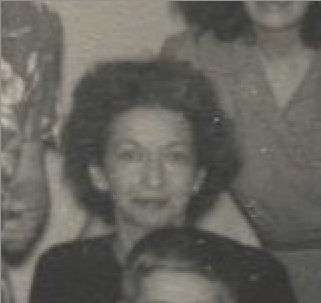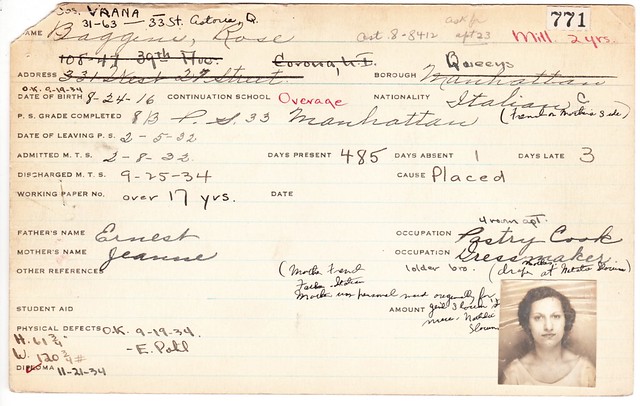
In the fourth installment of the Slate series from last September (or, as I'm now calling it, PermaRec 1.0), I spent a bit of time discussing the case of a student named Doris Abravaya, whose main card is shown above. Her full student record, which you can see here, told a heartbreaking tale of a very difficult childhood, typified by this entry:
May 2, 1933: Social worker, Mrs. Sklar, at Hebrew Sheltering and Guardian Society, came to see AK [Miss A. Kotter, the school's job placement counselor] about Doris. Doris's mother is insane and in Mental State Hospital. Father is paralyzed and crippled and a drunkard. Three children [including Doris] live in home of Mrs. Talianksy, obtained through the Society. There is severe unemployment in this home. When funds for Doris cease, on June 12, she will be entirely on her own. Doris has low mentality and is very timid and unstable. She constantly fears becoming like her mother. Children see mother often because father takes them there whenever he is intoxicated. Mrs. Sklar asked AK to try to include Doris in June graduation because not graduating would be such a disappointment.
There's more, most of it along those same lines. I was happy to see that Doris eventually got a clerical position that paid much better than the standard garment jobs that the school usually arranged for its students. Still, I worried for her, if it's possible to worry about someone who (a) you've never met and (b) is probably deceased already.
I wasn't able to find Doris's family during my research for PermaRec 1.0. But now, thanks to the work of volunteer researchers Catherine Bloomquist and Samantha Bulgerin, I've recently made contact with three of Doris's descendants -- a niece (who was named after Doris) and two daughters.
When Catherine and Sam pointed me toward the people they believed to be Doris's family, I was hesitant. Doris's story seemed so sad, and some of the things written in her student file were so harsh -- I feared that I might be stirring up bad memories.
But this wasn't the first time I'd faced this kind of decision. My rule for the project had always been to push forward and hope for the best. So I went ahead and contacted Doris's family.
And I'm really glad I did. Doris's niece and daughters have been fascinated by her student file -- in large part because it describes a girl who sounds very different from the smart, strong woman they knew. As it turns out, Doris had a good life despite the challenges she faced early on. I was -- I am -- extremely happy to hear that.
So far I've only had preliminary back-and-forths with Doris's family, but her daughters sound eager to tell her full story. And they live in the NYC area, so I hope to be able to meet with them in person soon and learn how Doris overcame her early hardships. I suspect it's going to be a very inspiring tale.




